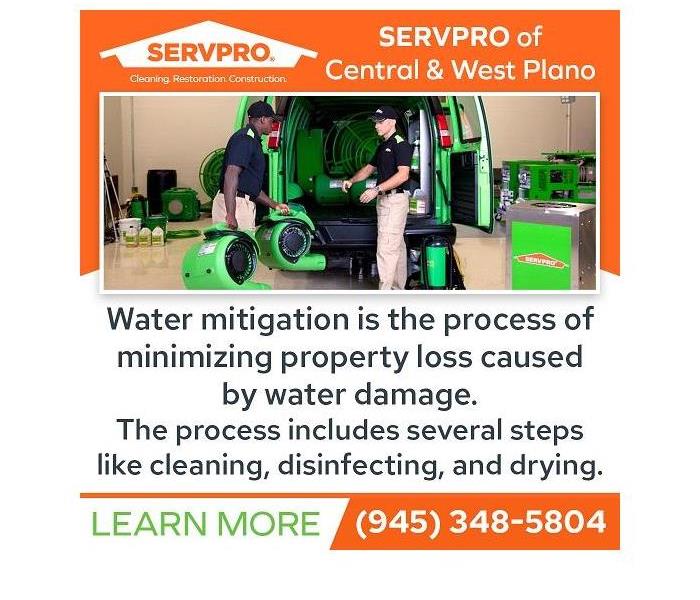Water Damage Mitigation Vs. Water Damage Restoration
10/22/2022 (Permalink)
Blog Summary: The difference between water damage mitigation and water damage restoration is explained by SERVPRO of Central & West Plano in this article.
Water damage can occur due to severe storms, leaking pipes, faulty appliances, and clogged drains. Most households and businesses will likely experience water damage due to multiple causes. When the damage is minimal, the property owners may handle it. However, a professional water damage restoration service may be needed for more severe water damage.
It is helpful if property owners have a basic understanding of the water damage restoration process. Several terms pop up when talking about water damage restoration. Some of them include water damage repair, water damage restoration, water removal, water remediation, and mitigation. Though these terms are often used interchangeably, sometimes there are minor differences between them. In this article, SERVPRO® of Central & West Plano explains how water damage mitigation differs from water damage restoration. SERVPRO of Central & West Plano is a company that offers Fire and Water - Cleanup and Restoration in Hunters Glen, TX, and surrounding areas. This locally owned company is mindful that homes mean much more than buildings; they are places filled with memories and emotions. Personnel at SERVPRO of Central & West Plano understand this and the importance of swift and thorough water damage restoration in limiting the risks of damage worsening.
When dealing with water damage, two of the most common terms encountered are water damage restoration and water mitigation. Many assume these two terms mean the same thing. However, there is a slight difference between these two terms, and this difference impacts the financial aspects. It would be helpful to know of this difference. Some insurance companies cover only water mitigation costs, while others only cover water damage restoration costs.
Water mitigation
Water mitigation is the process of minimizing property loss caused by water damage. The process includes several steps like cleaning, disinfecting, and drying. The cause of water damage is identified, and the source of water is stopped, if possible. Depending on the type of water (white, grey, or black), the category of water damage is ascertained. An action plan is implemented to remove standing water and residual moisture that will worsen the water damage if left unattended. The process of water mitigation can include the following steps:
- Removing damaged materials (like drywall and flooring) and furniture
- Cleaning and disinfecting salvageable objects and materials
- Using commercial-grade equipment to remove water and dry the area
- Boarding up windows, using tarps over damaged roofs, and other measures to protect the home from water or other natural elements are all part of water damage mitigation. For instance, a damaged roof can cause water to enter and cause further damage, so using a tarp can help. Removing debris like broken branches and loosened shingles, plugging holes, and reinforcing weak structures to prevent them from collapsing, are all part of the water mitigation process.
Expenses will be higher if there is a delay in water mitigation. This is because more water damage happens without mitigation, and more objects will need repair or replacement. Water damage mitigation aims to reduce the losses and repairs required to return a property to a preloss state.
Water damage restoration
Unlike water mitigation, water damage restoration focuses on repairing and restoring the water damage in a home or property. The process includes the repairs and building work done after water damage that restore the property to a preloss condition. Water damage restoration is done after water mitigation. This process intends a complete recovery from all water damage. SERVPRO of Central & West Plano has highly trained water damage restoration technicians who are IICRC-certified. They use state-of-the-art technology and specialized equipment for the water damage restoration process. The following may be part of the process, depending on the extent of water damage.
- Replacing damaged flooring and walls
- Replacing or repairing damaged roofs and ceilings
- Cleaning and sanitizing carpets, rugs, and upholstery that are not irreversibly damaged
- Cleaning and disinfecting the area
- Taking steps to reduce the risk of mold growth
To summarize, water mitigation's primary purpose is to limit water damage. All actions are to keep property and objects within it away from harm by exposure to water. Water mitigation is carried out first, and delays or failures in the process can worsen the water damage.
After water mitigation, water damage restoration begins. It aims to repair the water damage that has been sustained already. Delaying water damage restoration can lead to secondary water damage.
After any type of water damage, calling a reputable water damage restoration company without delay is essential. Professionals provide water mitigation and water damage restoration, and though technically, these services can be performed separately, they are all usually provided for the best outcome. For water damage restoration in Hunters Glen, TX, SERVPRO® of Central & West Plano can be approached. As a trusted leader in the restoration industry with a local presence, they can handle any disaster faster. SERVPRO of Central & West Plano will be the best to come to the rescue of a catastrophe of any size as they prioritize training and certification of employees. Call (945) 348-5804 or request help online from SERVPRO of Central and West Plano.






 24/7 Emergency Service
24/7 Emergency Service
